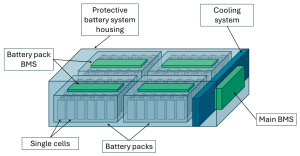How can I keep my batteries operating at their best with system monitoring and an inverter charger?
Nobody wants a power outage, regardless of the cause—a storm, an unstable power grid, or a dead battery. Reliability and sustainability are the keys to preventing blackouts in backup power systems. For numerous reasons, a lithium-ion battery system is the best; yet, for it to function at its best, it needs the right parts and regular maintenance.
Because they frequently live off the grid, RV owners need portable battery solutions to power their vehicles. When there is a power outage, homeowners depend on backup power to keep their houses operational. Business operations might be seriously disrupted by power outages. It is important for boat owners to know that their batteries have sufficient life to return them to land.
Let’s go over the importance of battery maintenance for power systems like monitoring systems and inverter chargers.

The significance of system maintenance
A battery monitor and inverter charger are essential components of a successful battery system. The battery’s DC power is transformed into AC power by an inverter charger so that appliances can run on it. Additionally, they change alternating current into direct current so that the battery system can be charged. Your battery system will function as effectively and as long as feasible if your inverter charger is maintained.
The amount of battery charge left is shown via the battery monitoring system. A suitable monitoring system can also record data on battery temperature, voltage, run time remaining, and power consumption rate.
For two reasons—it allows for energy optimization and prolongs the life of the lithium battery system—a battery monitoring system is helpful for maintaining batteries.
Tools and equipment for maintaining the inverter charger and monitoring system
The appropriate tools are needed for battery maintenance. You run the danger of electrical inefficiency, frequent maintenance, or even system failure if your system is not adequately monitored. Let’s examine the three most crucial instruments for maintaining batteries:
Multimeter
Electrical equipment’s voltage, current, and resistance can all be measured with a portable multimeter. A multimeter can be used to:
Examine the power source of the gadget.
Finding a malfunctioning switch.
Look for function lines.
Examine the extension cords.
Examine the battery
Because they provide you with an overview of the general condition of your battery system, these functions are crucial for battery maintenance.
Tester of loads
Battery voltage is measured by load testers under specific load scenarios. You may quickly and easily verify the functionality of your battery system with a load tester.
Battery observation
The battery monitor is a crucial tool for maintaining batteries. Users are able to fully comprehend their energy storage system by monitoring the voltage, current, capacity, and temperature of the batteries in real time.
Battery monitoring systems and inverter charger maintenance should be done correctly
If you follow a few easy steps, inverter chargers and battery monitors are easy to use. The kind of battery used in the system and its depth of discharge (DoD) should also be known. Lead-acid andlithium batteries differ greatly in terms of their DoD, or total energy density. Depletion of a battery over its life cycle is measured by its DoD. While lead-acid batteries can be damaged by draining them below 50% capacity, Maxworld Power lithium batteries can reach 100% depth of depletion (DoD). This process is known as sulfation. Consequently, it is advised against removing lead-acid batteries that are more than half of their rated capacity as this will shorten their lifespan.
Monitor lithium battery system
The best way to utilize your battery system is as follows:
The correct battery should be chosen because some are more resilient than others to prolonged use and severe drain. To maintain optimal battery health, select the LiFePO4 battery that best suits your requirements.
Including low-voltage disconnect: Select a lithium battery with a battery management system (BMS) that offers low-voltage disconnect safety, or use an inverter with this feature.
High-grade accessories: Make good use of the connections, cables, and extension cords that are included with your system.
Lead-acid battery ventilation that is adequate: Systems using lead-acid batteries produce heat when they work. Lead-acid battery systems should be kept cool by being placed in a well-ventilated area as part of proper battery maintenance. Ventilation is not necessary when using built-for-war lithium batteries, which are a safer alternative that may be positioned in any direction.
Only perform maximum maintenance on the battery.
Whether your energy storage devices run your house, company, boat, or recreational vehicle, you want the highest possible performance from them. Additionally, you can feel secure knowing that you are utilizing and storing dependable renewable energy sources in a safe manner.






